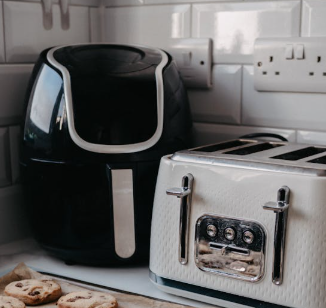
Air fryers have stormed Australian kitchens, promising quick, healthy meals with minimal effort.
Many households have embraced them as indispensable cooking companions, yet a hidden problem is quietly threatening our health.
What if your favourite gadget was putting you at risk without you even knowing it?
The Dirty Truth About Our Favourite Kitchen Gadget
With busy households craving convenience, air fryers have become the Swiss Army knife of modern kitchens.
Residential use accounted for 60 per cent of the market, driven by versatility and the desire for healthier cooking options.
Popularity, however, has not always translated into proper care.
A Reddit discussion revealed that many users treated their air fryers more like microwaves than true cooking equipment.
'Depends on what I cook. If grease or oil is left behind, I wash the basket and basket shell. If it's just crumbs, I wipe them out with a paper towel,' shared one user, reflecting the habits of many time-pressed home cooks.
Another admitted: 'Every two or three [uses] typically, obviously, if it's full of fat or something though, I'll clean it out.'
'All food contact surfaces should be cleaned after every use so that no debris remains. Any remaining organic material may allow potentially hazardous bacteria to grow to unsafe levels.'
Why This Casual Approach Could Cost You
Alexandra Reagan from Food Safety Plus warned that leftover food particles create a breeding ground for harmful bacteria.
'Any remaining organic material may allow potentially hazardous bacteria to grow to unsafe levels, which may in turn result in food poisoning,' Reagan said.
The risk increases because air fryers often operate at temperatures where bacteria can survive, unlike conventional ovens that reach higher heat for longer periods.
Common air fryer temperatures and bacteria risks
Most air fryers operated between 80°C and 200°C, but uneven heating and food debris could create cool spots where bacteria thrived.
The 'danger zone' for bacterial growth was between 5°C and 60°C—exactly where leftover food particles might sit between uses.
The Cleaning Reality Check
Even cleaning influencer Ramon Israel admitted he was 'guilty of not doing this' after every use.
'I wash my air fryer every two weeks, which is a little cheeky,' he confessed, though he recommended weekly cleaning for others.
Food safety experts were clear: this frequency was insufficient for safe food preparation.
Your Step-by-Step Cleaning Guide
Ramon's method, while infrequent, demonstrated correct technique.
For regular cleaning
- Let your air fryer cool completely after use
- Fill a Chux dish wand with warm water and dishwashing liquid
- Use the wand to scrub inside the basket, paying attention to corners and crevices
- Rinse thoroughly and dry completely before storing
For stubborn grime
- Add dishwashing liquid and two tablespoons of baking soda to the basket
- Fill with hot water and let sit for 10 minutes
- Use the Chux wand to remove loosened grime
- Rinse thoroughly and dry
Prevention Is Better Than Deep Cleaning
Smart air fryer users discovered ways to reduce cleaning without compromising safety.
'Line the bottom of the air fryer basket with a sheet of baking paper,' Ramon suggested.
'You can buy liners made for this, but to save money, just use regular baking paper and cut it to size.'
This simple step dramatically reduced food debris accumulation but did not eliminate the need for regular washing.
The Real Cost of Neglect
With the Australian air fryer market expected to reach $158.07 million by 2034 and durability concerns in lower-quality models, proper maintenance became crucial.
A decent air fryer cost between $80 and $300, far less than potential medical bills from food poisoning or the time lost recovering from illness.
Proper cleaning also extended the appliance’s lifespan, as built-up grease and food particles affected heating elements and fans, leading to uneven cooking and eventual breakdown.
Did you know?
Air fryer snacks take off Major retailers like Woolworths launched exclusive air fryer snack ranges, recognising how integral these appliances had become to Australian cooking habits.
What the Community Was Saying
The Reddit discussion highlighted widespread shortcuts in air fryer cleaning, with some users defending minimal care for certain foods.
One commenter advised: 'People seem to be really confused about air fryers. Clean them like you would any other dishes, or baking sheets, or casserole dishes, or pots, or pans or any other thing you used to cook food on.'
This simple mindset shift could prevent serious problems.
Example Scenario
- Sarah's experience Sarah from Melbourne used her air fryer daily but only cleaned it weekly. After experiencing recurring stomach issues, her doctor examined her food preparation habits. She discovered food buildup in hard-to-reach corners and immediately implemented daily cleaning. Her digestive issues resolved within two weeks.
Making Cleaning Easier
Air fryers were generally easier to clean than traditional deep fryers or ovens.
Most baskets and accessories were dishwasher-safe, and non-stick coatings made hand-washing quick.
Tips to simplify cleaning included:
Cleaning tips
- Clean while the basket was slightly warm—food came off more easily
- Keep a dedicated set of cleaning supplies nearby
- Use silicone air fryer liners for messy foods—they were reusable and dishwasher-safe
- Fill the basket with water and a drop of dishwashing liquid immediately after cooking greasy foods
The investment in proper care paid dividends for both safety and appliance longevity.
What This Means For You
Air fryers are now a common fixture in Australian kitchens, but many households do not clean them properly, leaving food debris behind that can harbour harmful bacteria and increase the risk of food poisoning.
Regular cleaning after every use, along with weekly deep cleans, is essential not only for food safety but also to ensure your appliance lasts longer and continues to perform efficiently.
Simple preventative measures, such as using baking paper liners and keeping dedicated cleaning tools nearby, can make maintenance easier and help prevent health risks.
For Australians over 60, taking these steps is particularly important, as the immune system may be more vulnerable to foodborne illnesses, making proper air fryer care a small effort that pays off in keeping you safe and healthy in your own kitchen.
Australia Air Fryer Market Report 2034 | Size & Share — Provides a detailed overview of the Australian air fryer market, projecting growth to AUD 158.07 million by 2034, driven by increasing demand for convenient cooking solutions.
https://www.expertmarketresearch.com.au/reports/australia-air-fryer-market
Australia Air Fryer Market Report 2034 | Size & Share — Highlights how new homeowners prioritising convenience and healthier cooking methods are driving demand for air fryers as low-fat cooking solutions.
https://www.expertmarketresearch.com.au/reports/australia-air-fryer-market
Air Fryer Market Share, Growth Analysis Report 2025-2034 — Notes that residential use accounted for 60 per cent of the market in 2024, due to convenience, versatility, and healthier cooking demands.
https://www.gminsights.com/industry-analysis/air-fryer-market
Australia Air Fryer Market Report 2034 | Size & Share — States that the Australian air fryer market, valued at AUD 61.50 million in 2024, is expected to reach AUD 158.07 million by 2034, with challenges including durability concerns in lower-quality models.
https://www.expertmarketresearch.com.au/reports/australia-air-fryer-market
Australia Air Fryer Market Report 2034 | Size & Share — Notes market challenges such as high purchase costs and durability issues in lower-quality models that may hinder adoption.
https://www.expertmarketresearch.com.au/reports/australia-air-fryer-market
Australia Air Fryer Market Report 2034 | Size & Share — Reports that Woolworths launched an exclusive air fryer snack range in November 2024, reflecting the rise in popularity of air fryers.
https://www.expertmarketresearch.com.au/reports/australia-air-fryer-market
What's your air fryer cleaning routine—have you been taking shortcuts or washing after every use?







